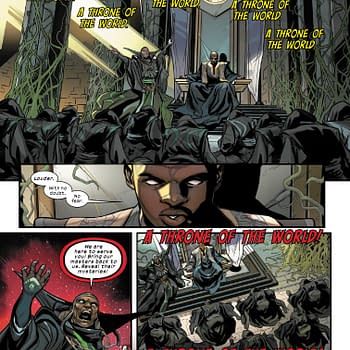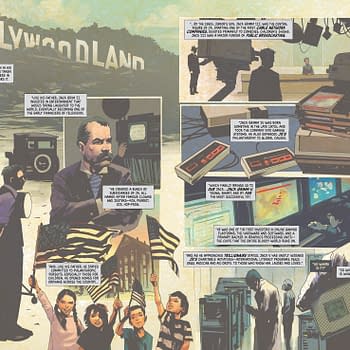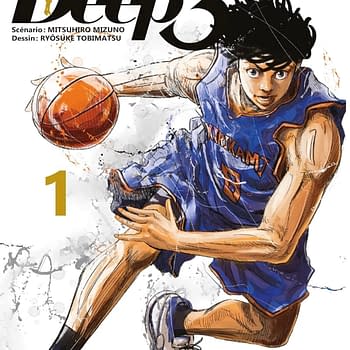Posted in: Comics | Tagged: Comics, dynamite, entertainment, Erik Mona, jonathan lau, Pathfinder: Worldscape
Writer's Commentary – Erik Mona Talks Pathfinder: Worldscape #3
Dynamite has sent over a new Writer's Commentary from Erik Mona for Pathfinder: Worldscape #3. The cover art is by Reilly Brown and interiors by Jonathan Lau.
Pathfinder Worldscape #3, the third issue in Dynamite's sword & sorcery crossover event, is on newsstands now. In the spirit of the holiday season, we thought it would be fun to take a closer look inside the issue with a writer's commentary that goes into absolutely obsessive detail about every single page. All right, nerds! Grab your issue and let's flip through this sucker together!
The issue's title, "The Light of Compassion," is a reference to a line of a prayer spoken by Kyra, the wise and goodly cleric of the Pathfinder team who serves as our point of view character for the issue. We've previously seen the fighter Valeros in #1 and Seoni the sorcerer in #2. Issue #4 will feature Merisiel the rogue in by far the strangest and most unexpected adventure so far, but that's getting considerably ahead of ourselves.
The issue opens with Kyra narrating her feelings about the city of Shareen and the multi-world reprobates who inhabit it. We've previously seen the city in issue #1, but this time we get a much better view of the place outside the arena. Jonathan Lau's pencils and Omi Remalante's colors bring Shareen to glorious life, with interesting characters and compelling visuals in the backgrounds and corners of nearly every panel.
Panel 1, which centers on a massive "summoning pillar" in far better condition than those that brought in our heroes in the first two issues, features a ton of Easter eggs, setting us off with a bang. Two human children in the howdah of an elephant trundle off the right border of the panel, with a Pathfinder RPG android near the right edge. Between them, a Pathfinder orc, a human, and a red Martian beat the snot out of an unseen figure who has just manifested in the Worldscape.
Kyra's speech here turns out to be a quote from a later scene in the issue. I've seen this trick used in television and movies a lot, and wanted to give it a shot here. I'm not sure it works as well as I wanted it to, but hey, if you don't experiment with form a little, you never get any better at your craft, so I'm ok with it.
Note that Kyra's reference to electrum and silver dollars reflects her time in the Worldscape. Electrum is a defunct currency from some other RPG, and silver dollars are from Earth. I had a whole scene in issue #4 focusing on the currency used in the Worldscape, a mixture of different coinages brought in from the three worlds. I also thought it would be fun if they used bullets for coinage too, given that they'd be extremely rare and folks would put a high value on acquiring the right caliber to reload the guns they brought in with them. Alas, this sort of worldbuilding minutia is exactly the sort of thing that gets cut when you run out of pages to get all your plot points in, so this brief reference is really all we're going to get within the comics themselves about the Worldscape's economy. Some day I hope to detail the Worlscape in one or more "proper" RPG products, and I'll have a lot more time and space for that kind of daydreaming.
I adore Jonathan Lau's opening panel here, with Kyra drawing her sword against the three villains beating up the newcomer. Check out that Pathfinder goblin fleeing toward us. Hearing a reference to Kyra's goddess Sarenrae is really all he needed to beat feet out of there.
Kyra's command that the thieves flee is more than just words. She's literally casting the spell "command" to force them to abandon their prey. Affected by her magic, the brigands flee, cursing Kyra's spellcasting powers and threatening to report her to the Holy Therns, about whom we'll be learning a great deal in pages to come.
Pay close attention to the hooded figure at the center of panel 5, who watches Kyra as she dispatches her foes and heals their wounded victim. While spellcasting and healing are rarities on the streets of Shareen, battles are so common that most folk don't even turn their heads to look at them. This hooded guy is an exception. Who could he be?
This page reveals the brigands' victim as Sir Mordred of Camelot. I searched high and low for a public domain comics depiction of Sir Mordred to use as the basis of his look in this sequence, but couldn't find one. Instead I asked Jonathan to create a darker version of Charles Ernest Butler's famous painting of King Arthur by way of Hal Foster's Prince Valiant. This is Mordred when he was a Knight of the Round Table, before his infamous betrayal, at about 18 years of age.
Background figures on this page are mostly from Jonathan, but if you look close you can see a machine man of Mars in panel 3 and another Pathfinder goblin in panel 4.
This awesome two-page splash spread provides us our best view yet of the hustle and bustle in Shareen, packed as it is with denizens from numerous timelines and alternate worlds. Let's touch on the word balloons of random snippets of crowd conversation before dissecting the imagery here.
Reference to "Phondari's airship" foreshadows one of the major villains introduced next issue, Phondari the black Martian "moon pirate" from the second arc of Dynamite's old Dejah Thoris comic. I really liked that character's carefree attitude, and thought she made a great addition to our team of villains. How could I resist adding an airship to the plot?
"She'll never get the true Crown from the First King…" is a reference to the immortal Empress Camilla's desire to unite the Worldscape's two controlling artifacts and make herself ruler of the place. She already has the Scepter, which she stole from Shareen's previous queen, Pha (a Thun'da supporting character we met in issue #1 and whom we'll see again shortly). The "First King," who holds the Crown, is the legendary Tarzan, at this point more of a looming figure than an actual participant in the story, but we'll be rectifying that before we're done (don't lose hope, Tarzan fans!). Tarzan is called the First King because he was the founder of the Council of Jungle Kings, an alliance of Golden Age comics jungle heroes that serves as one of the major forces in the Worldscape. Issue #6 focuses on this group extensively. Even though only a few of their members have appeared in this series so far, it's one of my favorite concepts in the entire series, and in the unlikely event that there's ever a spin-off of Pathfinder Worldscape, I'd love to do a series featuring the likes of Thun'da, Pha, King Rex, Cave Girl, Tabu, and Wambi. Start your letter campaign to Dynamite now, folks!
The only other "Easter Egg" among the crowd comments is a reference to yellow Martians, from the John Carter mythos. I didn't really get a chance to work any prominent yellow Martians into the Worldscape story, so I wanted to at least mention them here to remind folks that, even if you don't see them outside of a panel background, these guys are still present and a significant factor in the Worldscape. When writing panel descriptions and scenes set in Shareen, I'm trying to give the impression that the Worldscape is a vast enough setting to accommodate all kinds of adventures, not just the one I happen to be telling in the current series.
Visually, there's an awful lot going on in this spread, and much of it centers around "known" creatures and characters. Jonathan Lau also added a lot of oddball characters from his own imagination—some of these may indeed be references to specific ideas or characters he's familiar with. I love the idea that even I don't know all of the hidden stuff in these comics, and I've been thinking about this stuff for over a year!
From left to right, we've got a human butcher and blacksmith, arguing with a couple of patrons. At first I thought the guy complaining to the butcher was one of the aforementioned yellow Martians, but looking at him more closely it looks like a turtle shell is growing out of his back, so I honestly have no idea what is up with this dude.
The armored woman with the helmet leaning up against the building is an Amazon warrior from Bob Powell and Gardner F. Fox's post-Frank Frazetta Thun'da and Cave Girl comics, which were very influential to certain elements of the Worldscape's make-up. They're frankly my favorite of all the jungle comics I read to prepare for this series (excepting Fletcher Hanks's Fantomah, which is in a league of its own), and their "Dawn World" has been imported wholesale into the Worldscape, Amazons and all.
The right page features a Pathfinder dwarf, gnome (with a rat in his mouth, for some reason), bugbear (on the bridge), and minotaur, as well as a green Martian of Barsoom next to the minotaur and behind Kyra and Sir Mordred.
The most important character on this page, by far (at least to me!), is the bare-chested blond barbarian with the chest tattoo near the bottom right corner of the spread. This is my personal Pathfinder RPG character, Ostog the Unslain. Over the years I've snuck Ostog into the Pathfinder Adventure Card Game, two lines of Pathfinder miniatures (the prepainted version has yet to appear, but is in the pipeline), the back cover of the Pathfinder RPG Advanced Class Guide hardcover, and a few other places. As I have often said as Paizo's publisher, what good is absolute power if it doesn't corrupt you absolutely?
PAGE 6
Mordred and Kyra discuss the nature of the Worldscape and Shareen's current political landscape as they wander the city streets in search of a replacement sword for the one stolen from Mordred by the brigands in the first sequence. They pass a merchant selling replica Scepters and Crowns for Camilla's upcoming Tournament of Death. We've seen the preliminaries in issue #1, building toward a final grand finale in issue #5. Issue #3 takes place on the same day as much of issue #1 (as we'll soon see).
The armored man in the winged helmet in panel 2 is the most obscure Easter egg in the entire series. Not that anyone would ever know it without this article, but that's Valdar the Oft-Born, the protagonist of an 1895 fantasy novel of the same name by George Griffith. I purchased a gloriously beautiful edition of this work at a now-closed Fantasy Centre on a visit to London about 10 years ago. I spent a wonderful afternoon chatting with the two elderly shopkeepers, who insisted that I purchase the lovely edition and take it home as a keepsake of my visit. The book is about a reincarnating immortal hero (a specialty of mine, I'm afraid), and the illustrations always stuck with me. Valdar strikes me as exactly the sort of fellow who might find himself swept up in the Worldscape, so I asked Jonathan to add him into a panel.
I have no idea what the dude next to the green Martian in panel 4 is smoking, but I want some of that stuff, stat!
PAGE 7
Here we get another look at the Holy Therns of Barsoom, whom we last saw in issue #1 helping the arena master Xanesha capture Valeros for Camilla's Tournament of Death. The Therns come from "The Gods of Mars," the second John Carter book by Edgar Rice Burroughs. For my money, that book is the strongest of the Barsoom series, and it's one of my favorite planetary romance adventure stories, period. I knew going in that I wanted the Holy Therns to play an important part in the religious landscape of Shareen and the Worldscape.
The Therns' goddess, Issus, strikes me as the perfect deity for the killers of the prison dimension. Sure, she's a complete fraud (oh, SPOILER ALERT for a 100-year-old novel!), but that hasn't stopped belief in even more popular deities over the years, so I chalked that up as a bonus rather than a challenge. Issus's lack of ability to grant her followers spells (because she's fake) is key to the High Thern's prohibition against healers and spellcasters in Shareen. He doesn't want anyone showing up his cult or proving the inadequacy of his god with a little healing magic.
Dynamite adapted "The Gods of Mars" in their Warlord of Mars comic several years back (specifically in the "Heretics of Mars" story arc), but I frankly don't care for the "look" they went with in that series, which reminds me a bit too much of He-Man. I wanted sleeker, more dangerous-looking Therns, denuded of their ostentatious garb and wigs after long years in the Worldscape. These Therns have a bit of a Warboy modern primitive look to them that I think Jonathan pulls off well.
I didn't just make this change out of aesthetics. John Carter later points out that these are not the Therns of HIS Barsoom, another hint that the Worldscape draws in not just legendary warriors from different time periods of three worlds, but from different VERSIONS of those worlds altogether. In part this is to say "If you hate what I've done with these characters, just pretend it's a different version of them and it will all be OK." I dislike comic mega-crossovers that have no stakes to them, so I wanted to create a crossover where the heroes were plausibly THE main characters readers have been following for years, but also plausibly alternate versions. That means, I suppose, that any of these characters save the Pathfinders could be killed off at any minute.
I also wanted to introduce a John Carter who had already been through the events of "The Gods of Mars" that effectively ruin the Thern cult without getting rid of the Therns. Carter's experiences with the cult are critical to an upcoming scene, so this is a case of trying to have my cake and eat it too.
I'm getting pretty chubby with all of the cake this crossover series affords me. YUM YUM!
Incidentally, the guy with the white skin and the high red collar in the audience in panel 2 is a Vampire Man of Saturn, from the Warlord of Mars story arc of the same name.
PAGE 8
Mordred's inevitable betrayal portrays him as the kind of self-serving douche most well-read readers were probably already expecting him to be. If only Kyra had read a bit of Thomas Mallory she would never have trusted that little bastard in the first place.
PAGE 9
That said, Kyra is always ready to offer redemption to even the douchiest douches she encounters. She doesn't just believe it, it's in her doctrine! As the goddess Sarenrae represents redemption, Kyra believes even the basest villain can open their hearts to the light of compassion and redeem himself. She reminds Mordred that he told her he owed her his life, but he's already thinking several steps ahead and thinks the Therns make more powerful allies than some random woman, kind though she may be.
PAGE 10
Sir Mordred judged things poorly. Turns out that masked figure watching from the background has been trailing Kyra since he saw her heal Mordred at the summoning pillar. It also turns out he doesn't appreciate traitors, or those who side with Therns.
Turns out that hooded figure is John Carter of Mars.
Carter's appearance gives me the second chance in the series to pull the "use the character's logo in a word balloon to introduce him" cliché that, while corny, is simply too good to pass up.
PAGE 11
Nobody draws Holy Therns crackling and screaming while engulfed in holy fire like Jonathan Lau. The man is a genius.
Given that John Carter is from the late 19th century, I wanted to give him a bit of a subconsciously chauvinistic approach to women like Kyra. As he says in a future issue, "I do like a good rescue." Based on the events of his novels (themselves a product of their time), it's understandable why Carter might view women first and foremost as creatures to be rescued from harm.
Very few Barsoomian women—or Barsoomians period—can call down holy fire, however, so it soon becomes clear that Carter's bravado is not entirely called for.
PAGE 12
I love the struggling hand coming up from the bottom of panel 1 as Kyra sheathes her sword. Jonathan did a great job with Kyra here, showing her confident at the end of a battle that frankly wasn't all that difficult for her (the Pathfinders are getting up near the mid-level territory—they're a long way from where they were when they could barely beat a few goblins in their first story arc).
I do wish I'd pushed for a change in panel 2, however. The script calls for Carter to be smiling here as he praises Kyra's battle skills and magical prowess. I wanted to bring forward some of the love for fighting and joyfulness in the heat of battle critical to Carter's character in the Burroughs novels, and (coupled with the fact that the script also calls for Carter to be "smiling in delight" at Kyra's fire blast on the previous page instead of the look of surprise we actually get) losing the smile is a bit of a blow to his characterization in this scene. This is something most readers won't even notice, but I'd be lying if I said it didn't bug me at least a little on this read-through.
Panel 3 is one of several handshakes between the protagonists in the series. Valeros shakes Pha's hand in issue #1. Seoni shakes Thun'da's hand in issue #2. Merisiel shakes a couple of hands in #4, actually. Had I the forethought, I would have asked for all of these panels to be the same size so we could do an ad around them, or something. Yeah, ok, that's a dumb idea. But we COULD do it…
Panel 4 contains as concise a distillation of John Carter's core ethos as I could fit into a single word balloon. "To me, thinking and acting are the same thing." He says words to that effect so many times in the Burroughs novels that I had to include it here. In fact, those novels—told in the first person—are so tied up with Carter's inner monologue that I think some comic portrayals of the character can't quite live up to his character. I only wish I had more time and panels to delve deeper into Carter's psychology. The guy makes a lot of excuses for himself that I think a psychologist would find quite interesting. He often says things like "I simply cannot help that I spring headlong into action at the first sign of danger. My mind is simply incapable of any other course of action. Cowardice is a thing totally unknown to me." That's not an exact quote, but you get the picture. In his inner monologue, John Carter is kind of the king of the humble-brag, and I only wish I had more space to explore this in the series. But I don't, so we'll all have to satisfy ourselves with swashbuckling action, discussions of Barsoomian religion, and scenes that focus on one of the other 40-some characters featured in Pathfinder Worldscape.
Panel 5, with the blacksmith, features the series's second-most obscure cameo. That robotic, tentacle-armed thing on the floor is a Zorome, from Neil R. Jones's "Professor Jameson" science fiction stories, which were originally published in the late 1920s in Amazing Stories magazine. Paizo, the company that I co-run that publishes the Pathfinder RPG, briefly published Amazing Stories, and owns an entire archive of the pulp magazine going back to 1926. I've been obsessively going through those bound volumes for the last 12 years or so, and the Zorome stories are some of my favorites. I think maybe Jonathan thought they were so goofy-looking that he put a broken one on the floor in this panel as a way to tell me I was going too far with the cameos. And he was probably right!
PAGE 13
John Carter takes Kyra to Shareen's arena, to meet with the partner who helps him lead the resistance against Empress Camilla. The top panel gives us another merchant selling replica Scepters and Crowns, as well as a delightful image of folks eating cooked sea skates. I rather like to think that the things are the cryptids known as Jenny Hanivers, which we brought into the Pathfinder RPG as haniver gremlins, from Pathfinder Adventure Path #25. Those guys are tasty!
PAGE 14
Red Sonja returns to Pathfinder Worldscape in a bloody scene putting her against a warrior known as Hrothgar the Heavy-Handed. Hrothgar is of my own creation, and is not pulled from some obscure source (unfortunately). I would have liked to use some random public domain character here, but simply ran out of time. He isn't long for the world, however, so it doesn't really matter.
Kyra is disgusted by the bloodlust of the Worldscape. Even heroes like John Carter and Red Sonja—who both take absolute delight in carnage—are too much for her. She wants out of that arena ASAP.
PAGE 15
Carter's line that "Sonja once told me she was born in an arena" is a direct reference to Gail Simone's retelling of Red Sonja's origin, from the "Queen of Plagues" storyline a few years back. The suggestion in that tale is that Sonja developed most of her fighting skill as a fighting slave in a Zamoran arena, and that the "Red Sonja" appellation began there, with her life as a successful gladiator. In many ways the tragedy that took her family when she was a little girl set Sonja on her current path, but it wasn't until her arena days that she truly became the Red Sonja we know and love.
I liked the idea of Xanesha and Camilla capturing this great warrior and putting her in exactly the sort of position that had honed her into such a skillful weapon in the Hyborean Age. It's not as if Sonja enjoyed her time in the Zamoran arena—she hated it. In a way putting her in Shareen's arena was like throwing Br'er Rabbit into the Briar Patch. It's just not going to go as well as the villains think it is.
PAGE 16
The wizard Kulan Gath's first utterance in Pathfinder Worldscape is, appropriately enough, a warning that they should have killed Red Sonja when they had the chance. He should know. He's more or less been Red Sonja's arch-enemy since 1972's Marvel Team-Up #79, where he battled the She-Devil AND the spectacular Spider-Man. Kulan Gath features prominently in many of Dynamite's Red Sonja comics, and is even the big bad in the current Dynamite "main" Red Sonja series by Amy Chu.
I know, I know. Red Sonja needs more ongoing villains than just Kulan Gath, but come on. I had to use this guy. He featured prominently in my favorite two-issue arc of Uncanny X-Men when I was a 10-year-old kid, and he's probably the most recognizable Red Sonja supporting character in her entire run. Plus he's got a great look, and I needed a "high-level" wizard for my villain team (who we'll be seeing much more of next issue). We'll get more into Kulan Gath and his plan for domination of the Worldscape next issue. For now, his appearance is an appetizer for things to come.
PAGE 17
As Kyra and John Carter descend into the lower levels of Shareen's arena, they pass the warrior queen Pha—previous owner of the Scepter—on her way to her own battle in the preliminary tournament to determine Camilla's final champion. This aligns the events of this issue firmly during the events of the last half of issue #1. Pha is on her way to fight Valeros, a battle we've already seen.
PAGE 18
The bottom of this page sees Kyra begin the prayer that makes up the narration for page 1. Again, I'm not sure how well this technique works, but I'm glad I at least tried it!
Kyra's eyes were supposed to be shut in contemplative prayer here, which is why there's a panel on the next page focusing on her open eye. I missed that one when looking over the final pencils. Shame on me!
PAGE 19
I was very interested to explore Kyra's conundrum here. She hates almost everything about the darkness of the Worldscape, but as a servant of Sarenrae, it's her holy duty to bring the light of compassion to that darkness. She wants to leave (assuming she knew how), but everything she has been taught, everything she believes tells her to stay and fight.
PAGE 20
Sometimes I get an idea for a scene before I know anything else that's going to happen in a given issue, and this page is as good an example of that as anything I've ever written. Once I worked out which guest stars would pair with which Pathfinder character, I knew I wanted to stage this conversation about religion. I'm fascinated by the difference in approach to faith in the three worlds of the Worldscape. On Earth belief in God is a pure act of faith. On Barsoom, religion is a fraud. On Golarion, the gods are demonstrably real. John Carter struck me as the perfect person to pair Kyra with during her crisis of faith, and I'm really pleased that I had enough room in my plot for a quiet moment like this.
PAGE 21
Red Sonja really needs to see a barber immediately once she gets out of her current predicament. We're seeing her here moments after defeating Valeros at the end of issue #1. Kyra doesn't know it yet, but that blood covering Sonja's face and armor belongs to one of her best friends. As they walk toward a chamber that will allow Kyra to prove her allegiance to John Carter and Red Sonja's alliance, Sonja lays out a bit more about their plan.
PAGE 22
Readers have been asking about Valeros's fate since the final panel of the first issue, in which he appeared to have been killed by Red Sonja. Well, he's not dead yet—not quite, anyway. Only the healing magic of Sarenrae can bring him back from the brink!
And that's where we leave our heroes at the end of Pathfinder Worldscape #3. Next month, we'll see what Merisiel's been up to since coming to the Worldscape in what should prove to be our most surprising and unusual issue yet! And, shortly after that comes out, I'll be here with an insanely long, obsessively detailed behind the scenes article for all eight of you to enjoy! Thanks for supporting the series, and we'll see you in the Worldscape!
Follow Erik Mona on Twitter @erikmona, and check out his new website at erikmona.com!




















